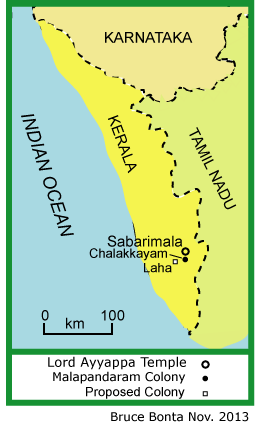A news story last week reported that the sexual exploitation of Malapandaram women, reported two years ago, does not appear to be improving. A major Indian newspaper carried a story in November 2011 indicating that Malapandaram women living near Chalakkayam, a settlement colony in Kerala close to the famous temple at Sabarimala, were frequently targeted with sexual harassment, both by outsiders and by their own men.
 The same newspaper, The Hindu, implies in its report last week that the situation is still just as bad, or worse. The recent story, written by a journalist named Radhakrishnan Kuttoor, provides a lot of details. The paper quotes Satheesh, a young, literate Malapandaram man who is employed by the Tribal Welfare Department. He told the paper that there is rampant sexual abuse and exploitation of women and girls in the Malapandaram settlement.
The same newspaper, The Hindu, implies in its report last week that the situation is still just as bad, or worse. The recent story, written by a journalist named Radhakrishnan Kuttoor, provides a lot of details. The paper quotes Satheesh, a young, literate Malapandaram man who is employed by the Tribal Welfare Department. He told the paper that there is rampant sexual abuse and exploitation of women and girls in the Malapandaram settlement.
A year ago, a few forest officials were alleged to have sexually molested three girls in the forest at Ponnanpara, near Chalakkayam. When a television channel reported the story the next day, the tribal families were quickly moved to a more remote forest area in Achencoil. The Malapandaram were reluctant to say anything more about the crime, fearing reprisals from the perpetrators.
Satheesh also tells Mr. Kuttoor that the Malapandaram girls are sexually exploited by their neighbors and family members, and they are sometimes forced into incestuous relationships. He alleges that women are viewed as sex objects in the community. They complain of sexual exploitation and cruelty but the police and the forest officials do nothing about it.
These stories are hard to square with the ethnographic reports of Brian Morris, who did careful fieldwork among the Malapandaram in the 1970s. Morris reported in his 1982 book Forest Traders that Malapandaram women were treated as complete equals by men, a pattern that he saw as diametrically opposed to that of the surrounding Hindu society. In contrast to the Malapandaram, women in the majority Hindu society of Kerala at the time were segregated or completely excluded from many social activities such as worship in temples, travel on public buses, and service in teashops.
The journalist writing for The Hindu last week does not mention the writings of Morris, nor does he speculate on whether the anti-female social patterns may, in fact, be developing in Malapandaram society as an outgrowth of the people having ever closer contacts with their Hindu neighbors.
The Hindu article does quote another local authority on Malapandaram society, P. S. Uthaman, who suggests a variety of positions and campaigns for “the uplift of the tribe,” in Mr. Kuttoor’s words. Mr. Uthaman says that the situation of the women in the forested regions near Moozhiyar, Sayippinkuzhy, and Gavi is pathetic also. Evidently, about 59 nomadic Malapandaram families, averaging 10 to 15 people each, live in that area, and 37 families with about 200 people total live in the Chalakkayam area.
The District Tribal Development Officer, O.A. Rasheed, told the reporter that the department would soon establish another settlement colony for the Malapandaram on 4.4 hectares of forest land near Laha, where his agency would “rehabilitate” 26 families. However, he told Mr. Kuttoor, the Malapandaram rarely prefer to settle in a colony. Mr. Uthaman adds that the young people are eager to settle in the proposed colony and end their nomadic forest lifestyles. They advocate living in close contact with both human habitations and with the forest.
The District Collector, Pranab Jyotinath, visited the forest areas near the proposed colony in May. He argued that it is important to educate the Malapandaram on the value of living in a community and of becoming part of the mainstream of society.
Mr. Uthaman appears to have the same view. He advocates allotting five acres of land for each tribal family under the provisions of the national Forest Rights Act, where they should be “rehabilitated on the land.” He argues that the resettlement should be monitored by a committee which would include Malapandaram individuals as well as Tribal Welfare Department officials. The committee should monitor and support the development of farming and the education of tribal children.
In one key paragraph of the article, Mr. Uthaman indicates that the Malapandaram are now becoming affected by anemia and malnutrition, especially the women and children. Morris (1982) predicted that tendencies to settle and give up their nomadic forest lifestyle would be detrimental to the Malapandaram. He wrote, prophetically, that as long as they subsisted primarily on gathered wild forest foods they would continue to have a high protein intake. Settling into subsistence agriculture would serious affect their nutrition, he argued.
“Perhaps [their] general reluctance to take up agriculture, even with the support and encouragement of welfare officials, reflects their awareness of the ‘path to progress’ that lies ahead—of what it means, in terms of basic livelihood, to sever the links that hold them to the forest,” Morris concluded (p.108).